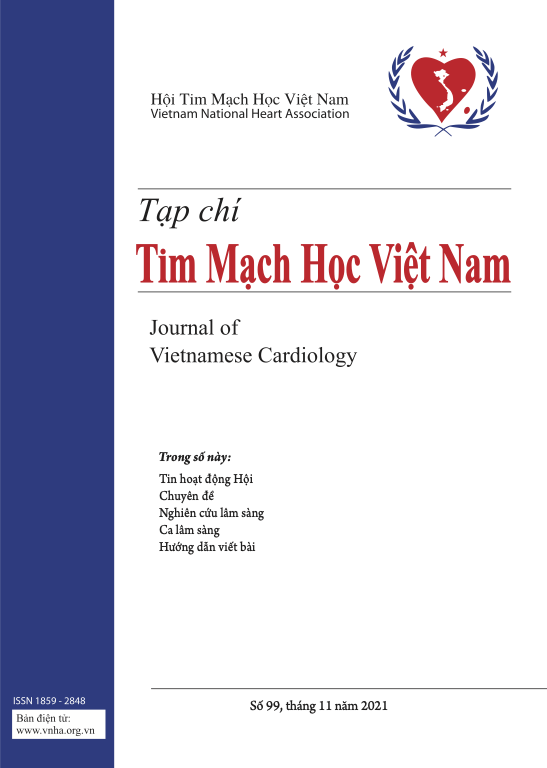Quality of life and its related predictors among acute coronary syndrome patients with coronary stents in Ho Chi Minh City, 2022
DOI:
https://doi.org/10.58354/jvc.112E.2024.469Từ khóa:
Quality of Life, Acute Coronary Syndrome, stents insertion, resilienceTóm tắt
The health-related quality of life (HRQOL) assessment after coronary stents insertion to issue a very crucial tool for evaluating outcomes. Therefore, we investigated the associations between healthy affect, resilience to improve their health status and the quality of life of patient is improving. A cross-sectional design involving patients with having acute coronary syndrome (ACS) after coronary stents insertion (CSI) and being treated in the hospital in Ho Chi Minh City. The patients (N =210) who came to Tam Duc Heart Hospital for pre- examination during treatment were asked to answer questionnaires which included SF-36 and resilience-25. The t-test and ANOVA was applied to identify the factors related to quality of life and resilience. Result showed the mean score of resilience is 70.2 ± 8.1. The score of physical components summary (PCS) was range from 32.37 to 61.6 and the mean score was 51.0 ± 8.7. For the mental component summary (MCS) was range from 39.6 to 60.0 with the mean score was 51.0±5.7. Factors including age, gender, marital status, working status, education, duration after stent treatment, experience of hospitalization for stent treatment, number of stents in patients and regularly take medication were associated with patients’ quality of life. The mean score of quality of life was significantly different between patients’ resilience level (p < 0.05).
Tài liệu tham khảo
Benjamin EJ, Muntner P, Alonso A, et al. Heart Disease and Stroke Statistics-2019 Update: A Report From the American Heart Association. Circulation. 2019;139(10):e56-e528. doi:10.1161/CIR.0000000000000659
![]()
Townsend N, Wilson L, Bhatnagar P, et al. Cardiovascular disease in Europe: epidemiological update 2016. Eur Heart J. 2016;37(42):3232-3245. doi:10.1093/eurheartj/ehw334
![]()
Vietnam. Coronary heart disease Tropical Hospital. 2019.
![]()
Campbell-Sills L, Forde DR, Stein MB. Demographic and childhood environmental predictors of resilience in a community sample. J Psychiatr Res. 2009;43(12):1007-1012. doi:10.1016/j.jpsychires.2009.01.013
![]()
Connor KM, Davidson JR. Development of a new resilience scale: the Connor-Davidson Resilience Scale (CD-RISC). Depress Anxiety. 2003;18(2):76-82. doi:10.1002/da.10113
![]()
Thu PH, Thuy DT, Hung NV. Study on applying the questionnaire SF-36 to assess the quality of life in patients with rheumatoid arthritis. Medical Research. 2017;106(1):146-54.
![]()
Moriel M, Tzivoni D, Behar S, et al. Contemporary treatment and adherence to guidelines in women and men with acute coronary syndromes. Int J Cardiol. 2008;131(1):97-104. doi:10.1016/j.ijcard.2007.09.005
![]()
Rawal S, Sawant AC, Sridhar M, et al. Impact of Intravascular Brachytherapy on Patient-Reported Outcomes in Patients with Coronary Artery Disease. Cardiovasc Revasc Med. 2020;21(12):1550-1554. doi:10.1016/j.carrev.2020.05.032
![]()
Yeng SH, Gallagher R, Elliott D. Factors influencing health-related quality of life after primary percutaneous coronary intervention for ST-elevation myocardial infarction. Appl Nurs Res. 2016;30:237-244. doi:10.1016/j.apnr.2015.09.002
![]()
Bønaa KH, Mannsverk J, Wiseth R, et al. Drug-Eluting or Bare-Metal Stents for Coronary Artery Disease. N Engl J Med. 2016;375(13):1242-1252. doi:10.1056/NEJMoa1607991
![]()
Xue C, Bian L, Xie YS, et al. Impact of smoking on health-related quality of Life after percutaneous coronary intervention treated with drug-eluting stents: a longitudinal observational study. Health Qual Life Outcomes. 2017;15(1):1. doi:10.1186/s12955-016-0578-4
![]()
Rofiyati W, Pangastuti H. Factors Associated Quality of Life Patients with Coronary Stent in Dr Sardjito Hospital Yogyakarta. Jurnal Ners Dan Kebidanan Indonesia. 2020;8(9).
![]()
Kim HS, Kim HK, Kang KO, et al. Determinants of health-related quality of life among outpatients with acute coronary artery disease after percutaneous coronary intervention. Jpn J Nurs Sci. 2019;16(1):3-16. doi:10.1111/jjns.12209
![]()








